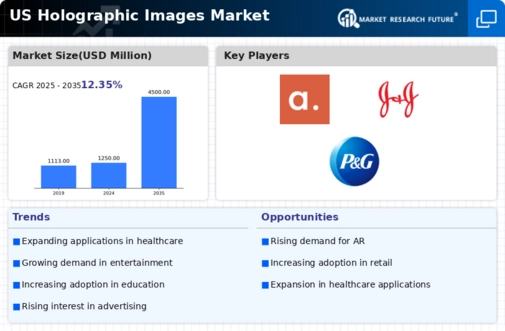The holographic images market is currently characterized by a dynamic competitive landscape, driven by rapid technological advancements and increasing applications across various sectors, including entertainment, healthcare, and education. Major players such as Microsoft (US), Google (US), and Apple (US) are at the forefront, each adopting distinct strategies to enhance their market positioning. Microsoft (US) focuses on innovation through its HoloLens platform, which integrates augmented reality (AR) with holographic imaging, while Google (US) emphasizes partnerships with educational institutions to expand the use of its AR technology in learning environments. Apple (US), on the other hand, appears to be investing heavily in research and development to integrate holographic capabilities into its existing product lines, suggesting a long-term vision for immersive user experiences.
In terms of business tactics, companies are increasingly localizing manufacturing and optimizing supply chains to enhance efficiency and reduce costs. The market structure is moderately fragmented, with a mix of established players and emerging startups. This fragmentation allows for diverse innovations but also intensifies competition among key players, who are vying for market share through strategic collaborations and technological advancements.
In October 2025, Microsoft (US) announced a significant partnership with a leading healthcare provider to implement holographic imaging solutions in surgical procedures. This collaboration is poised to enhance surgical precision and training, indicating Microsoft's commitment to expanding its holographic applications beyond traditional sectors. The strategic importance of this move lies in its potential to revolutionize medical practices, thereby opening new revenue streams and solidifying Microsoft's position as a leader in the healthcare technology space.
In September 2025, Google (US) launched a new holographic display technology aimed at enhancing virtual collaboration tools. This initiative is particularly relevant in the context of remote work, as it seeks to provide more immersive and interactive experiences for users. The strategic significance of this development is underscored by the growing demand for effective remote communication solutions, positioning Google (US) favorably in a competitive market increasingly focused on digital transformation.
In August 2025, Apple (US) unveiled its latest AR headset, which incorporates advanced holographic imaging capabilities. This product launch is a critical step in Apple's strategy to integrate holographic technology into its ecosystem, potentially reshaping consumer interactions with digital content. The importance of this launch cannot be overstated, as it reflects Apple's ongoing commitment to innovation and its intent to capture a larger share of the immersive technology market.
As of November 2025, current trends in the holographic images market are heavily influenced by digitalization, sustainability, and the integration of artificial intelligence (AI). Strategic alliances among key players are shaping the competitive landscape, fostering innovation and collaboration. Looking ahead, it is likely that competitive differentiation will increasingly pivot from price-based strategies to a focus on technological innovation, reliability in supply chains, and the ability to deliver unique user experiences. This shift underscores the importance of adaptability and forward-thinking in maintaining a competitive edge in the evolving market.

















Leave a Comment